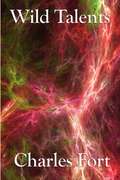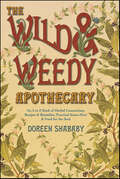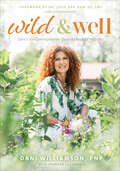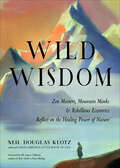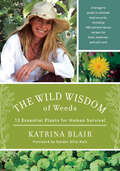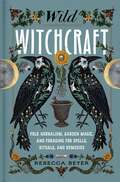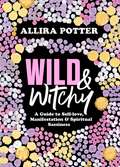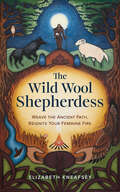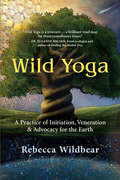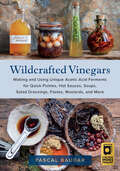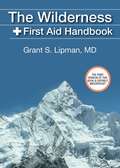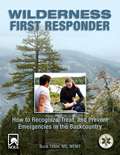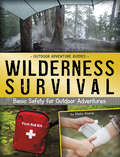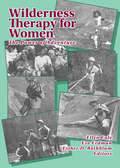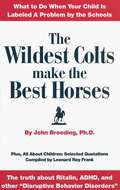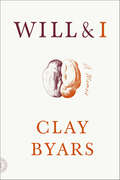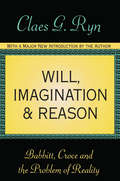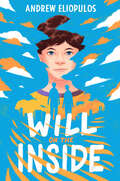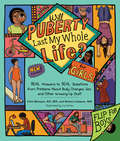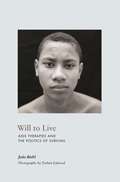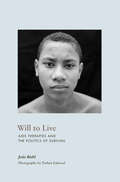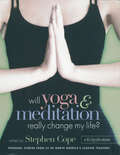- Table View
- List View
Wild Talents
by Charles FortLike Fort's previous works, Wild Talents deals with a number of anomalous phenomena and Fort's ongoing attack on scientific dogma. Though not as well known as some of his other works, Wild Talents is arguably Fort's best work. Fort's writing style and tongue-in-cheek sense of self-deprecating humor is on full display in this book. As a result, this book is generally easier to read than his earlier works.
Wild & Weedy Apothecary: An A to Z Book of Herbal Concoctions, Recipes & Remedies, Practical Know-How & Food for the Soul
by Doreen ShababyJust outside your doorstep or kitchen window, hidden beneath a tall pine tree or twining through porch latticework, a wild and weedy apothecary waits to be discovered.Herbalist Doreen Shababy shares her deep, abiding love for the earth and its gifts in this collection of herbal wisdom that represents a lifetime of work in the forest, field, and kitchen. This herbalism guidebook is jam-packed with dozens of tasty recipes and natural remedies, including Glorious Garlic and Artichoke Dip, Sunny Oatmeal Crepes, Candied Catnip Leaves, Lavender Lemonade, Roseberry Tea, Garlic Tonic, Parsnip Hair Conditioner, and Dream Charms made with Mugwort.A sampling of the herbal lore, legend, and instruction found within these pages:The difference between sweet-faced flowers and flowers with attitudeHow to assemble a well-stocked pantryThe importance of gratitudePlant-spirit communication basicsHow to use local wild herbsHow to make poultices, teas, tinctures, balms, and extractsPraise:"Those who dare delve into this book may emerge with catnip on their breath, mud on their knees, wild fruit juices on their hands, and a mysterious, satisfied smile—the very image of a wild and weedy woman. Come on!"—Susun S. Weed, wild woman herbalist
Wild & Well: Dani’s Six Commonsense Steps to Radical Healing
by Dani Williamson Jennifer Lill BrownWild & Well helps readers reclaim the health they were born with and live life to the fullest.
Wild Wisdom: Zen Masters, Mountain Monks & Rebellious Eccentrics Reflect on the Healing Power of Nature
by Neil Douglas-KlotzInspiration from wilderness mystics from around the world, including Henry David Thoreau, Bai Juyi, Rainer Maria Rilke, Lalla, Rachel Carson, and more.Sages and mystics throughout the centuries have sought inspiration in the wildness of nature. This little book gathers the sayings and stories of the women and men who have sunk their roots deep into inner retreat and brought forth wisdom for all times and peoples.Here we find the stories and voices of desert fathers and mothers, forest hermits, mountain mystics, wandering philosophers, and wise eccentrics who maintained their solitude while living in society and challenged the status quo with humor. From East and West and everything in between. From Christian hermits, wandering Kabbalists, itinerant Sufis, Zen practitioners, Yogis, court jesters, transcendentalists, and freethinkers, Wild Wisdom gathers a timeless harvest for spiritual renewal.By turns witty, startling, beautiful, and sublime, Wild Wisdom makes a fine companion for personal retreat, daily contemplation, or simply taking time out during a busy day.
The Wild Wisdom of Weeds: 13 Essential Plants for Human Survival
by null Katrina BlairThe Wild Wisdom of Weeds is the only book on foraging and edible weeds to focus on the thirteen weeds found all over the world, each of which represents a complete food source and extensive medical pharmacy and first-aid kit. More than just a field guide to wild edibles, it is a global plan for human survival. When Katrina Blair was eleven she had a life-changing experience where wild plants spoke to her, beckoning her to become a champion of their cause. Since then she has spent months on end taking walkabouts in the wild, eating nothing but what she forages, and has become a wild-foods advocate, community activist, gardener, and chef, teaching and presenting internationally about foraging and the healthful lifestyle it promotes. Katrina Blair&’s philosophy in The Wild Wisdom of Weeds is sobering, realistic, and ultimately optimistic. If we can open our eyes to see the wisdom found in these weeds right under our noses, instead of trying to eradicate an &“invasive,&” we will achieve true food security. The Wild Wisdom of Weeds is about healing ourselves both in body and in spirit, in an age where technology, commodity agriculture, and processed foods dictate the terms of our intelligence. But if we can become familiar with these thirteen edible survival weeds found all over the world, we will never go hungry, and we will become closer to our own wild human instincts—all the while enjoying the freshest, wildest, and most nutritious food there is. For free!The thirteen plants found growing in every region across the world are: dandelion, mallow, purslane, plantain, thistle, amaranth, dock, mustard, grass, chickweed, clover, lambsquarter, and knotweed. These special plants contribute to the regeneration of the earth while supporting the survival of our human species; they grow everywhere where human civilization exists, from the hottest deserts to the Arctic Circle, following the path of human disturbance. Indeed, the more humans disturb the earth and put our food supply at risk, the more these thirteen plants proliferate. It&’s a survival plan for the ages.Including over one hundred unique recipes, Katrina Blair&’s book teaches us how to prepare these wild plants from root to seed in soups, salads, slaws, crackers, pestos, seed breads, and seed butters; cereals, green powders, sauerkrauts, smoothies, and milks; first-aid concoctions such as tinctures, teas, salves, and soothers; self-care/beauty products including shampoo, mouthwash, toothpaste (and brush), face masks; and a lot more. Whether readers are based at home or traveling, this book aims to empower individuals to maintain a state of optimal health with minimal cost and effort."Katrina Blair&’s charming and intelligent The Wild Wisdom of Weeds … delivers just about the best argument I&’ve read for the futility of figuring out what, exactly, qualifies as a native plant and why &‘invasive&’ can be a flawed concept."—New York Times&“The Wild Wisdom of Weeds is one of those rare and important books that has the capacity to radically alter your view of a world you thought you knew well. You'll never look at weeds the same again!&”--Ben Hewitt, author of The Nourishing Homestead
Wild Witchcraft: Folk Herbalism, Garden Magic, and Foraging for Spells, Rituals, and Remedies
by Rebecca BeyerLearn how to cultivate your own magical garden, begin your journey with folk herbalism, and awaken to your place in nature through practical skills from an experienced Appalachian forager and witch.Witchcraft is wild at heart, calling us into a relationship with the untamed world around us. Through the power of developing a relationship with plants, a witch—beginner or experienced—can practice their art more deeply and authentically by interacting with the beings that grow around us all. Bridging the gap between armchair witchcraft and the hedge witches of old, Wild Witchcraft empowers you to work directly with a wide variety of plants and trees safely and sustainably. With Wild Witchcraft, Rebecca Beyer draws from her years of experience as an Appalachian witch and forager to give you a practical guide to herbalism and natural magic that will share: -The history of witchcraft and Western herbalism -How to create and maintain your own herbal garden -Recipes for tinctures, teas, salves, and other potions to use in rites and rituals -Spells, remedies, and rituals created with the wild green world around you, covering a range of topics, from self-healing to love to celebrating the turning of the seasons -And much more! Wild Witchcraft welcomes us home to the natural world we all dwell in by exploring practical folk herbal and magical rites grounded in historical practices and a sustainable, green ethic.
Wild & Witchy
by Allira PotterManifesting queen and influencer Allira Potter has devised a &“guidebook&” for life that will allow readers to bring in their most abundant life ever.Imagine your dream life. Who are you with? What are you doing? How do you feel? If you&’re ready to call in everything you ever wanted, from a new lover to your perfect job, manifesting queen Allira Potter knows the secret to creating an abundant AF life. Growing up with a single mum who worked multiple jobs to keep the family afloat, Allira started out with nothing. When she lost her mum at just 17, her life became a wild ride of ups and downs. Married by 22 and divorced five years later, she then navigated mental health issues, financial insecurity, substance abuse and hitting rock bottom... until she came across a deck of oracle cards her mum had left her. That was the day everything changed. In a few short years, Allira turned it all around, harnessing the power of manifestation to curate the life of her dreams. In Wild & Witchy, she shares her journey and how you, too, can work through loss and grief, build unbreakable self-worth, learn to love every bit of yourself and identify your values. In this &‘guidebook for life&’, written in Allira&’s trademark unapologetic, no-f*cks-given style, you&’ll find tasks, tools, techniques and a few witchy rituals to help you bring in your most abundant life ever. &‘[The cover art is] inspired by the flowering gum trees that blossom in the spring and summer time, usually there are a variety of colours including soft and vibrant pink tones. This piece is a reflection of the joy the bush brings to me over the warmer months. The dot work reflects the blossoms, cheerfully opening up and saying hello on Country.&’ – Cover artist Shanai Kellett @ Malogaart
The Wild Wool Shepherdess: Weave the Ancient Path, Reignite Your Feminine Fire
by Elizabeth KneafseyReconnect to the wisdom of the land, animals and the moon, and be inspired to find your power and freedom in this poetic memoir.Do you long to be amongst nature, in the wild, remote, untouched places, where the moon nears full, and the energy is visible and present? Do you feel as if you don&’t really belong, and that there is something missing in your life?Full of incredible and transformative stories of a life with her flock, and wolf companion, ancient craft techniques, animal messengers, sacred places and Indigenous wisdom, Elizabeth Iekawehatie Kneafsey tells the story of how she found her place in the world, and how you can find your unique path, too.From her childhood in a Nottinghamshire pit village, to creating a new life in harmony with nature and rediscovering the wild woman within, this book will show you that it is possible to live a different way – one where you are deeply connected to the earth, animals, and your powerful feminine wisdom.
Wild Yoga: A Practice of Initiation, Veneration & Advocacy for the Earth
by Rebecca WildbearAwaken Your Wild Nature and Deepen Your Relationship with Earth This wonderfully fresh and revelatory book invites you to create a personal yoga practice that seamlessly melds health and well-being with spiritual insight, Earth stewardship, and cultural transformation. Wilderness guide and yoga instructor Rebecca Wildbear came to yoga after a life-threatening encounter with cancer in her twenties. Over years of teaching and healing, she devised the unique and user-friendly practice she presents in Wild Yoga. In this book, she guides you in connecting to the natural world and living from your soul while also addressing environmental activism. Whether you are new to yoga or an experienced practitioner, by engaging in this vibrant approach, you’ll discover greater levels of love, purpose, and creativity, along with the active awareness we know our planet deserves.
Wildcare: Working In Less Than Desirable Conditions And Remote Environments
by Frank HubbellIntended to be used as curriculum materials to obtain Wilderness First Responder Certification. It is also a good guide to wilderness medicine and extreme first aid.
Wildcrafted Fermentation: Exploring, Transforming, and Preserving the Wild Flavors of Your Local Terroir
by null Pascal Baudar&“I am in awe of this book&”―Sandor Katz, author of The Art of FermentationWild krauts and kimchis, fermented forest brews, seawater brines, plant-based cheeses, and more with over 100 easy-to-follow recipes! Featured in The Independent&’s (UK) &“7 Best Fermentation Books of 2020&”One of the most influential tastemakers of our time invites you on an extraordinary culinary journey into the lacto-fermentation universe of common wild edibles. Used for thousands of years by different cultures all around the world, lacto-fermentation is the easiest, safest, and most delicious way to preserve food. And nature provides all the necessary ingredients: plants, salt, and the beneficial lactic acid bacteria found everywhere.In Wildcrafted Fermentation, Pascal Baudar describes in detail and through step-by-step color photos how to create rich flavorful ferments:At homeFrom the wild plants in your local landscapeFrom the cultivated plants in your gardenFrom sauerkrauts and kimchis to savory pastes, hot sauces, and dehydrated spice blends, Baudar includes more than 100 easy-to-follow, plant-based recipes to inspire even the most jaded palate. The step-by-step photos illustrate foraging, preparation, and fermentation techniques for both wild and cultivated plants that will change your relationship to the edible landscape and give you the confidence to succeed like a pro.So much more than a cookbook, Wildcrafted Fermentation offers a deeply rewarding way to reconnect with nature through the greens, stems, roots, berries, fruits, and seeds of your local terroir. Adventurous and creative, this cookbook will help you rewild your probiotic palate and &“create a cuisine unique to you and your environment.&”
Wildcrafted Vinegars: Making and Using Unique Acetic Acid Ferments for Quick Pickles, Hot Sauces, Soups, Salad Dressings, Pastes, Mustards, and More
by null Pascal Baudar*2022 Foreword INDIES Book of the Year Award Silver Winner for CookingAward-winning author and forager Pascal Baudar uncovers incredible flavors and inspiring recipes to create unique, place-based vinegars using any landscape.Includes more than 100 delicious, easy recipes for quick pickles, soups, sauces, salad dressings, beverages, desserts, jams, and more!&“[Wildcrafted Vinegars] celebrates the versatility of this all-important—but often overlooked—acid in the kitchen.&”—Plate MagazineAfter covering yeast fermentation (The Wildcrafting Brewer) and lactic acid fermentation (Wildcrafted Fermentation), pioneering food expert Pascal Baudar completes his wild fermentation trilogy by tackling acetic acid ferments and the wide array of dishes you can create with them. Baudar delves deeply into the natural world for wild-gathered flavors: herbs, fruits, berries, roots, mushrooms—even wood, bark, and leaves—that play a vital part in infusing distinctive gourmet-quality vinegars.More than 100 recipes show how to use homemade vinegars to make a wide range of delicious foods: quick pickles, soups, sauces, salad dressings, beverages, desserts, jams, and other preserves.Recipes include:Pine, fir, and spruce–infused vinegarSmoked mushroom and seaweed vinegarBlueberry-mugwort vinegarWilder curry vinaigretteWasabi ginger vinegar saucePickled walnutsMountain oxymelAnd many more!Once you&’ve mastered the basic methods for making and aging vinegars at home, you might be inspired to experiment on your own and find local plants that express the unique landscape and terroir wherever you happen to live. Or you might decide to forage for ingredients in your own garden or at a local farmers market instead. Either way, Pascal Baudar is an experienced and encouraging guide to safe and responsible wild-gathering and food preservation.&“Pascal Baudar is a culinary visionary.&”—Sandor Ellix Katz, author of The Art of Fermentation
The Wilderness First Aid Handbook: 1
by Grant S. LipmanThe Wilderness First Aid Handbook is a handy, quick-reference guide easily accessible with basic wilderness first aid knowledge, but it does not require advanced degrees or experience with medicine and prehospital care. <P><P>Recognizing that certain knowledge and procedures are outside the scope of a layperson's training, Dr. Grant Lipman limits the use of technical terms and advanced techniques that may be unfamiliar to some readers or beyond their comfort zone. This system-based, easy-to-follow guide assists the first aid provider when encountering most wilderness emergencies, from cold and heat concerns and blister treatments to high altitude illness and lightning injury prevention--and much more. Typically the most challenging decision in the wilderness environment is when to evacuate a sick or potentially sick person, and as such, each section has detailed decision-making steps to inform you of when to be concerned and when to get out. This guidance is based upon the recent evidence-based consensus statement published by the Wilderness Medical Society on the scope of practice of wilderness first aid. Filled with original, full-color artwork illustrating the techniques and procedures described and with internal-spiral binding and waterproof pages handy for travel into extreme environments, The Wilderness First Aid Handbook is a must-have for every back pocket or backpack.
Wilderness First Responder: How to Recognize, Treat, and Prevent Emergencies in the Backcountry
by Buck TiltonWilderness First Responder is a comprehensive text for the recognition, treatment, and prevention of emergencies happening in the wild. It's essential reading for wilderness instructors, trip leaders, guides, search and rescue groups, and anyone who works or plays far from definitive medical care. This invaluable resource includes expert, step-by-step instructions, clear illustrations, and "Signs and Symptoms" sidebars designed to help you provide immediate - whenever you are more than an hour away from an ambulance or a hospital. You'll learn how to conduct a patient assessment, improvise when ideal materials are not handy, and decide whether or not to evacuate a patient. Learn how to assess and treat: Airway obstructions Cardiac arrest External and internal bleeding Shock Spine injuries Head injuries Chest injuries Abdominal injuries Fractures and dislocations Athletic injuries Soft-tissue injuries Cold-or heat-induced injuries.
Wilderness Survival: Basic Safety for Outdoor Adventures (Outdoor Adventure Guides)
by Blake HoenaLightning and bugs and bears - oh my! This handy guidebook provides basic tips and tricks to surviving in the wilderness, including sheltering against weather extremes, battling bugs, and fending off meddlesome animals. With bold photos and infographics, step-by-step projects, and expert instructions, OUTDOOR ADVENTURE GUIDES will have first-time campers and enthusiasts alike opting outside.
Wilderness Therapy for Women: The Power of Adventure
by Ellen Cole Esther D Rothblum Eve M TallmanWilderness Therapy for Women offers women risktaking adventure activities in the outdoors as an alternative to traditional therapy. The contributing authors illustrate the empowerment, confidence, and self-esteem women can derive from adventure and experiential activities. This is the first book of its kind devoted to the symbolic value of wilderness accomplishments to women’s mental health. Wilderness Therapy for Women unites women with nature and each other by lifting the social constraints surrounding women in adventure pursuits. It offers women a new method of healing while developing an appreciation for the uniqueness of the environment. Daring experiences in the outdoors rekindles a sense of strength and a respect for the provider of that strength. A therapeutic experience from the outdoors provides women with an awareness of their capabilities to strengthen and preserve themselves and their surroundings. This book is divided into four parts: Theoretical Perspectives, Wilderness Therapy in Action, Special Populations, and Personal Narratives. Readers will find many topics of interest including: Body image and wilderness therapy The therapeutic value of the wilderness Ethical considerations of experiential therapy Ropes courses for women All-women’s river trips Special populations: rape and incest survivors, welfare mothers, and mid-life women. Intended as a guide book, Wilderness Therapy for Women is ideal for mental health professionals who are either practicing wilderness therapy or merely inquisitive about it. Outfitters and professional outdoor leaders will benefit from chapters on theory, applications, and special populations. Outdoor program administrators and educators who must remain on the cutting edge of their industry will also profit from this book.
The Wildest Colts Make the Best Horses
by John BreedingDr. Breeding presents evidence that we are drugging our children, particularly our young boys, bor behavior that we used to consider normal but now label as problem behavior. He postulates that we are abusing our children with drugs like Ritalin and should welcome rambuntious bahavior in our young children as it represents creativity and the best in normal development.
Will & I: A Memoir
by Clay Byars“Byars recounts his struggle to master a body shattered by tragedy . . . A fascinating, if chilling, meditation on the aftermath of trauma.” —Publishers WeeklyClay Byars was recovering at home from a near-fatal car crash when he suffered a massive stroke. He was just eighteen years old. He awoke, back in the hospital, and was told he would be paralyzed from the eyes down for the rest of his life.Determined to defy the odds, Clay quickly and miraculously began to recover his mobility but discovered just how different his life would be—a disparity embodied by his identical twin brother, Will. As Will went on to graduate from college, marry, and start a family, Clay carved out a unique existence, doing the seemingly impossible by living on his own on a remote farm in Alabama.With haunting clarity and heartrending honesty, Will & I tells the unlikely story of Clay’s life and his coping mechanisms, including weekly singing lessons that not only teach him to use his voice but remind him of his will to exist. In this singular and striking meditation on vulnerability and vitality, we’re invited to see how Clay sees the world—and how the world sees him—as he bravely challenges himself and his abilities at every turn.“A visceral, electric memoir.” —Dannye Romine Powell, The Charlotte Observer“[An] intensely powerful memoir . . . Compact, substantial and thoroughly compelling—reminiscent of neurosurgeon Paul Kalanithi’s posthumous bestseller, When Breath Becomes Air.” —Alice Cary, BookPage“[A] memoir of recovery against considerable odds . . . A stark, honest book that reads like a writer’s apprenticeship amid harrowing circumstances.” —Kirkus Reviews
Will I Still Be Me?: Finding a Continuing Sense of Self in the Lived Experience of Dementia
by Christine BrydenWhat does a dementia diagnosis mean for an individual's sense of self? Christine Bryden shares her insider view on living with dementia and explains how a continuing sense of self is possible after diagnosis and as the condition develops.Encouraging a deeper understanding of how individuals live meaningfully with dementia, the book challenges the dominant story of people with dementia 'fading away' to eventually become an 'empty shell'. It explores what it means to be an embodied self with feelings and emotions, how individuals can relate to others despite cognitive changes and challenges to communications, and what this means for the inclusion of people with dementia in society.
Will, Imagination, and Reason: Babbitt, Croce and the Problem of Reality
by Claes G. RynWill, Imagination, and Reason sets forth a new understanding of reality and knowledge with far-reaching implications for the study of man and society. Employing a systematic approach, Claes Ryn goes to the philosophical depths to rethink and reconstitute the epistemology of the humanities and social sciences. He shows that will and imagination, together, constitute our basic outlook on life and that reason derives its material and general orientation from the interaction between them.The imaginative master-minds novelists, poets, composers, painters, and others powerfully affect the sensibility and direction of society. Sometimes a distorting, self-serving willfulness at the base of their visions draws civilization, including reason, into dangerous illusion. More penetrating and balanced vision and rationality spring from a different quality of will. Ryn explains the kind of interplay between will, imagination, and reason that is conducive to a deepened sense of reality and to intellectual understanding. He argues that human life and self-knowledge are inescapably historical. In developing his dialectical view of intellect, he draws from Irving Babbitt, Benedetto Croce, and other philosophers to refute positivistic, formalistic, and ahistorical theories of knowledge and to develop his alternative.Advancing a systematic epistemological argument, Ryn throws much new light on the nature of reason but also on central issues of ethics and aesthetics. This trenchant and original work is indispensable to philosophers, social, political and cultural theorists, literary scholars, and historians.
Will on the Inside
by Andrew EliopulosAfter dedicated soccer player Will is sidelined from the season—and his friend group—due to complications from his newly diagnosed Crohn’s disease, he finds himself figuring out who he really is on the inside in this heartfelt and thoughtful middle grade novel that's perfect for readers who love books by Maulik Pancholy and Christine Day. <P><P> Will loves playing center midfield on his middle school soccer team. This year, though, Will hasn't felt like himself; his stomach has been bothering him, and he has no energy at all. When his new doctor diagnoses him with Crohn's disease, Will hopes that means he’ll start feeling better soon and he can get back to playing with his team before the season ends. <P><P> But Will's new medicines come with all kinds of side effects. Forced to sit out afternoon practice, Will finds himself hanging out with a kid at school, Griffin. This could be a real problem, seeing as Griffin just asked Will’s best friend to the spring dance. As in, guy friend. What would Will’s teammates say if they knew the whole story? Not to mention Will’s friends at church. <P><P> With all these changes happening faster than he can process them, Will knows that he has a lot to figure out about who he really is on the inside.
Will Puberty Last My Whole Life?: REAL Answers to REAL Questions from Preteens About Body Changes, Sex, and Other Growing-Up Stuff
by Julie Metzger Robert Lehman Lia CerizoAn expanded and revised edition of the popular flip book for preteens. One half of the book is filled with questions commonly asked by girls entering puberty, and the other half with questions asked by boys. "If you can only afford one book on puberty for this age group, this is the one to have."--School Library JournalThis book contains informative, honest, and reassuring answers to questions that preadolescents have about puberty--from friendships and feelings, to pimples, babies, body hair, menstruation, bras, and much more. Straightforward, age-appropriate answers are provided by an experienced nurse-and-physician team who have been giving seminars to preteens and their parents throughout the Pacific Northwest and Bay Area for more than 25 years. Each question in the book has been asked by kids during their classes (many of them frequently). This new edition also contains updated language throughout and additional questions and answers regarding sex, sexuality, consent, and gender identity and norms.The book is also filled with lighthearted and often humorous full-color illustrations throughout.
Will to Live: AIDS Therapies and the Politics of Survival (In-Formation)
by João BiehlWill to Live tells how Brazil, against all odds, became the first developing country to universalize access to life-saving AIDS therapies--a breakthrough made possible by an unexpected alliance of activists, government reformers, development agencies, and the pharmaceutical industry. But anthropologist João Biehl also tells why this policy, hailed as a model worldwide, has been so difficult to implement among poor Brazilians with HIV/AIDS, who are often stigmatized as noncompliant or untreatable, becoming invisible to the public. More broadly, Biehl examines the political economy of pharmaceuticals that lies behind large-scale treatment rollouts, revealing the possibilities and inequalities that come with a magic bullet approach to health care. By moving back and forth between the institutions shaping the Brazilian response to AIDS and the people affected by the disease, Biehl has created a book of unusual vividness, scope, and detail. At the core of Will to Live is a group of AIDS patients--unemployed, homeless, involved with prostitution and drugs--that established a makeshift health service. Biehl chronicled the personal lives of these people for over ten years and Torben Eskerod represents them here in more than one hundred stark photographs. Ethnography, social medicine, and art merge in this unique book, illuminating the care and agency needed to extend life amid perennial violence. Full of lessons for the future, Will to Live promises to have a lasting influence in the social sciences and in the theory and practice of global public health.
Will to Live: Aids Therapies and the Politics of Survival
by Joâo Biehl Torben EskerodWill to Live tells how Brazil, against all odds, became the first developing country to universalize access to life-saving AIDS therapies--a breakthrough made possible by an unexpected alliance of activists, government reformers, development agencies, and the pharmaceutical industry. But anthropologist Jo#65533;o Biehl also tells why this policy, hailed as a model worldwide, has been so difficult to implement among poor Brazilians with HIV/AIDS, who are often stigmatized as noncompliant or untreatable, becoming invisible to the public. More broadly, Biehl examines the political economy of pharmaceuticals that lies behind large-scale treatment rollouts, revealing the possibilities and inequalities that come with a magic bullet approach to health care. By moving back and forth between the institutions shaping the Brazilian response to AIDS and the people affected by the disease, Biehl has created a book of unusual vividness, scope, and detail. At the core of Will to Live is a group of AIDS patients--unemployed, homeless, involved with prostitution and drugs--that established a makeshift health service. Biehl chronicled the personal lives of these people for over ten years and Torben Eskerod represents them here in more than one hundred stark photographs. Ethnography, social medicine, and art merge in this unique book, illuminating the care and agency needed to extend life amid perennial violence. Full of lessons for the future, Will to Live promises to have a lasting influence in the social sciences and in the theory and practice of global public health.
Will Yoga & Meditation Really Change My Life?: Personal Stories from 25 of North America's Leading Teachers; A Kripalu Book (A\kripalu Book Ser.)
by Stephen CopeStephen Cope asked 25 yoga and meditation teachers to share their "tales from the path" – their thoughts on how the long-term practice of yoga and meditation has changed their lives. The result is a unique collection of stories offering insight and inspiration for everyone seeking a more satisfying life.
